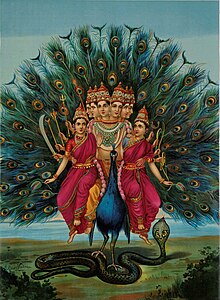Tirumurukāṟṟuppaṭai

Tirumurukātṟuppatai (Tamil: திருமுருகாற்றுப்படை, meaning Guide to Lord Murugan) is an ancient devotional Tamil poem in the Sangam literature genre entirely dedicated to the god Murugan. Murugan is described as the nephew of the god Vishnu, who is called Mayon or the ruler of the worlds.[1] Authored by Nakkiranar, it is the first poem in the Ten Idylls (Pattuppāṭṭu) anthology.[1] The poem is generally dated to the late classical period (2nd to 4th century CE),[2] with some scholars suggesting it may have been composed a few centuries later.[3]
| Part of a series on |
| Hindu scriptures and texts |
|---|
 |
| Related Hindu texts |
The anthologies and poems of the Sangam literature have numerous references and verses to Murugan – also known as Subrahmanya, Kumara, Skanda, Kartikeya in other parts of India.[4] The Tirumurukarruppatai poem is exclusively about different manifestations and shrines of Murugan. It describes different major temples dedicated to him in the Tamil region, six locations, the natural scenes, worship practices and the culture of the people.[4][5]
Description
[edit]The Tirumurukarruppatai has 312 akaval meter verses, states Zvelebil.[6] According to Francis, the critical editor has 317 verses.[7] It describes the beauty and the warrior nature of Murugan, six sacred shrine regions of Murugan, legends such as the killing of Surapadma, his six faces and the twelve arms along with their functions. The Hindu god is described as a gentle erotic lover of goddesses as well as a gruesome bloody warrior on the battlefield.[6][7] This elaboration includes 30 verses on the beauty of every body part of heavenly maidens.[8] Metaphors refer to Indra, kantal flowers, emerald sea and others to paint "magnificent natural scenes", states Zvelebil. The poem highlights the peacock and his war banner flag. Both his consorts Devasena – the daughter of the Vedic god of rain, thunder and war Indra, and Valli – the Kuruvar Vedar girl, are included in the poem. It also mentions the Vedas and has numerous loanwords from the classical Sanskrit literature.[9]
Murugan, as described in the Tirumurukarruppatai, has features that include those found in ancient north Indian descriptions of Skanda. According to Zvelebil, this may reflect that the Tirumurukarruppatai was composed after significant interactions between north and south India had already happened. Murugan's father Shiva and mother Korravai (Parvati, Durga) are also reverentially covered in the poem.[10]
The Tirumurukāṟṟuppaṭai is not only a part of the Sangam literature, it is also part of another Tamil textual canon, as the eleventh of twelve Tirumuṟai. The twelve Tirumurais (books) are the devotional Tamil corpus in the Hindu Shaiva tradition in Tamil Nadu. The Tirumurukarruppatai was likely included in this corpus for god Shiva, because Murugan is one of his sons and the historic reverence for the text.[7] The text is part of these two anthologies, but in some Tamil Hindu communities, the Tirumurukarruppatai manuscripts are found as a separate text, on its own, as a devotional guide.[7]
See also
[edit]References
[edit]- ^ a b Zvelebil 1973, pp. 125–126.
- ^ Zvelebil 1973, pp. 119–126.
- ^ Zvelebil 1973, p. 130.
- ^ a b Linda Penkower; Tracy Pintchman (2014). Hindu Ritual at the Margins: Innovations, Transformations, Reconsiderations. University of South Carolina Press. pp. 28–30. ISBN 978-1-61117-390-1.
- ^ Zvelebil 1973, pp. 125–128.
- ^ a b Zvelebil 1973, pp. 125–127 with footnotes.
- ^ a b c d Emmanuel Francis (2017). "The Other Way Round: From Print to Manuscript" (PDF). In Vincenzo Vergiani; Daniele Cuneo; Camillo Alessio Formigatti (eds.). Indic Manuscript Cultures through the Ages: Material, Textual, and Historical Investigations. De Gruyter. pp. 321–322. doi:10.1515/9783110543100. ISBN 978-3-11-054312-4.
- ^ Abraham Mariaselvam (1988). The Song of Songs and Ancient Tamil Love Poems: Poetry and Symbolism. Gregorian. p. 245. ISBN 978-88-7653-118-7.
- ^ Zvelebil 1973, pp. 129–131 with footnotes.
- ^ Zvelebil 1973, pp. 129–130 with footnotes.
Bibliography
[edit]- Mudaliyar, Singaravelu A. (1983) [1931]. Apithana Cintamani, An encyclopaedia of Tamil Literature. New Delhi: Asian Educational Services.
- Pillai, M. S. Purnalingam (1994). Tamil Literature. Asian Educational Services. p. 115. ISBN 81-206-0955-7.
- Ray, Himanshu Prabha (2003). The archaeology of seafaring in ancient South Asia. Cambridge: Cambridge University Press. ISBN 9780521011099.
- Robinson, Edward Jewitt (2001). Tamil Wisdom: Traditions Concerning Hindu Sages and Selections from Their Writings. New Delhi: Asian Educational Services.
- Selby, Martha Ann (2011). Tamil Love Poetry: The Five Hundred Short Poems of the Aiṅkuṟunūṟu, an Early Third-Century Anthology. Columbia University Press. ISBN 9780231150651.
- Takahashi, Takanobu (1995). Tamil Love Poetry and Poetics. BRILL Academic. ISBN 90-04-10042-3.
- Zvelebil, Kamil (1973). The Smile of Murugan: On Tamil Literature of South India. BRILL. ISBN 90-04-03591-5.
- Zvelebil, Kamil (1992). Companion studies to the history of Tamil literature. BRILL. p. 73. ISBN 90-04-09365-6.


 French
French Deutsch
Deutsch